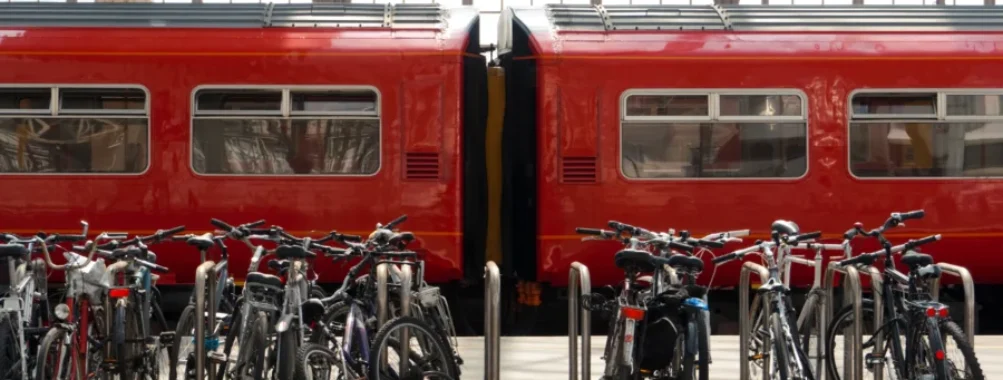
Train Travel with Bike Germany Rules: 7 Essential Tips for a Hassle-Free Journey
Thinking about exploring Germany with your bike? You’re definitely not the only one—it’s honestly one of my favorite ways to experience both the countryside and urban life in a single trip. Most German trains will let you bring your bike, but there are a bunch of rules you really want to know before you show up at the station. Trust me, nothing kills the mood faster than getting denied at the door because you missed a ticket or have no clue where to stash your bike.
On my first trip, I totally missed that there were special bike sections—squeezing your bike into the wrong car is, well, not a great look. If you want a smooth ride, you need to know which ticket to grab, where you should board, and a couple of tricks for finding space—especially when the train’s packed.
Table of Contents
- Key Takeaways
- Key Rules for Train Travel with Bikes in Germany
- Overview of Bicycle Transport Regulations
- Bicycle Ticket and Reservation Requirements
- Identifying Bike-Friendly Trains
- Allowed Bicycle Types and Restrictions
- Bicycle Tickets and Reservations
- How to Buy a Bike Ticket
- Bicycle Space Reservation Process
- Additional Ticket Fees
- Free Bike Transport Scenarios
- Types of Trains and Their Bike Policies
- Regional Trains: RE, RB, and S-Bahn
- Intercity and IC/EC Trains
- ICE Trains: National High-Speed Services
- International Trains: EuroCity and TGV
- How to Identify and Access Bike Spaces on Trains
- Understanding the Bicycle Symbol
- Finding Bike Compartments and Coaches
- Loading and Unloading Bicycles
- Using Deutsche Bahn Services for Bike Travel
- Booking via Bahn.de and DB Navigator App
- Getting Help from DB Agencies
- Support for Connecting Journeys
- Regional Differences and Transport Associations
- Berlin and Brandenburg: S-Bahn and Beyond
- Potsdam and Surrounding Regions
- Traveling near Borders: Poland Connections
- Coordinating with Regional Transport Associations
- Practical Tips for Cycling and Train Journeys
- Combining Bike Rental and Train Travel
- Timing Your Travel with Peak Hours
- Storing Bikes and Avoiding Fines
- Frequently Asked Questions
- What are the specific guidelines for bringing a bicycle on a Deutsche Bahn train?
- Is a special ticket required to take a bike on trains within Germany?
- How do travelers handle foldable bikes on German train services?
- What are the restrictions for taking bicycles on buses in Germany?
- Are there any differences in rules for bicycle transport on regional vs. long-distance trains in Germany?
- Can electric bicycles also be taken on board German trains, and if so, are there any additional considerations?
- Book Your Dream Experience
- More Travel Guides
Key Takeaways
- You’ll need a bike ticket and to board in the right section on most German trains.
- Rules and bike spots change depending on train type and region.
- Practical tips can make your trip way easier.
Key Rules for Train Travel with Bikes in Germany
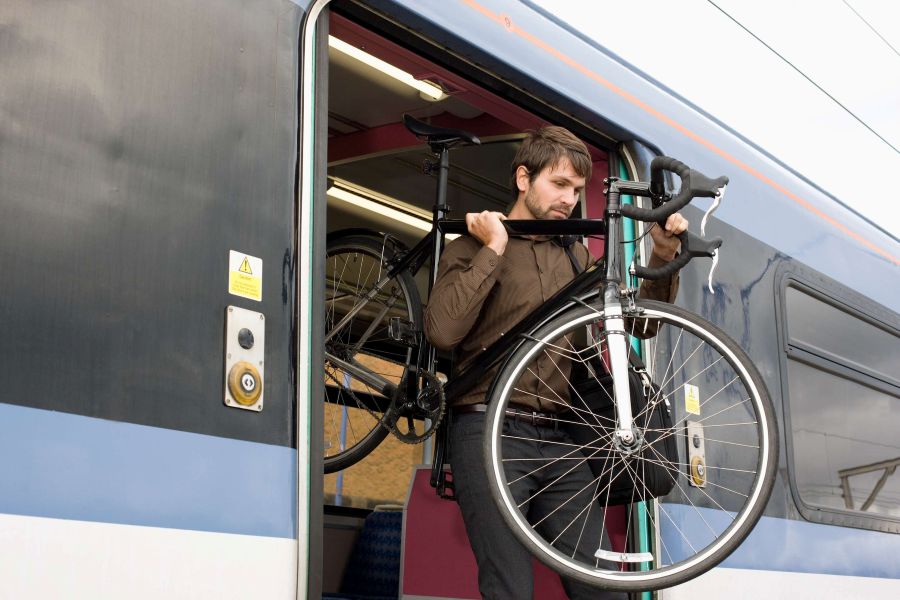
Bringing your bike on a German train isn’t brain surgery, but the rules can be sneaky if you don’t pay attention. If you’re planning to mix trains and bike paths, knowing about ticketing, choosing trains, and which bikes are allowed will save you hassle (and maybe a little embarrassment).
Overview of Bicycle Transport Regulations
Bikes generally get the green light on most local and regional Deutsche Bahn trains, but the details—when, where, and how—can shift depending on your route, the state, and even the hour. Some transit networks ban bikes during rush hour, which is super annoying if your schedule isn’t flexible.
You’ll spot a bicycle symbol near certain carriages or doors. That’s your signal—if you don’t see it, you’re in the wrong spot. You load your own bike and have to secure it so it doesn’t block anyone. Conductors sometimes check, so don’t count on being able to sneak by.
I’ve definitely scrambled to move my bike after missing the right sign (and once I spilled my coffee everywhere). Just keep your eyes open and you’ll dodge that chaos.
Bicycle Ticket and Reservation Requirements
Here’s the scoop: you usually need a bicycle ticket (sometimes called a bike or cycle ticket). For regional trains, it’s a flat daily fee—pretty straightforward—but you won’t get a reserved spot. If the train’s jammed, you might end up waiting for the next one. That’s a bummer, especially if it’s pouring.
Long-distance trains (like IC and EC) require both a bike ticket and a reservation for your bike—just having a seat for yourself isn’t enough. You can buy these at the Deutsche Bahn automat, online, or at the ticket counter. That reservation guarantees your bike a place, so don’t skip it on busy routes.
Quick tip: Always double-check if your ticket covers the whole trip, especially with transfers or border crossings—rules can flip once you leave your starting state.
Identifying Bike-Friendly Trains
Not every train welcomes bikes. Local services like Regionalbahn (RB), Regional-Express (RE), Interregio-Express (IRE), and most S-Bahn lines will let you bring your bike, if there’s space and you’ve got the right ticket. Look for the blue or white bike symbol by the doors or on digital boards—it’s a lifesaver.
ICE trains are a different beast. You can only bring a bike if it’s folded in a special bag or you’ve pre-booked a spot (and not every ICE offers this). I’ve been caught out before—don’t assume your bike fits just because it did yesterday! Always check your train on the Deutsche Bahn app or website before you leave.
And honestly, don’t even try sneaking a bike onto Thalys or certain cross-border trains—they really don’t mess around with those rules.
Allowed Bicycle Types and Restrictions
Most regular bikes, kids’ bikes, and folded folding bikes are fine if they’re not huge. Pedelecs (e-bikes with pedal assist up to 25 km/h and a 250w motor) count as standard bikes. Fat bikes sometimes fit, but check your tire width—if you have to, let out some air (just remember your pump).
Cargo bikes, tandems, and bikes with trailers usually don’t make the cut on regional trains—space is a real issue. Deutsche Bahn gets stricter on long-distance trains; they only want “normal” bikes that fit their racks. Always double-check the rules for each leg of your trip. If your bike’s the wrong type, the conductor might actually turn you away, which is not fun with a train full of people watching.
Quick checklist for allowed bikes:
- Standard adult bikes
- E-bikes/pedelecs (≤25 km/h, ≤250 watts)
- Folding bikes (when folded)
- Children’s bikes
- Fat bikes (if space and width allow)
Not usually allowed: Cargo bikes, tandems, bikes with trailers.
Double-check the latest rules before you go—regulations change more often than you’d think.
Bring patience, a backup plan, and—if you’re anything like me—a snack or two.
Bicycle Tickets and Reservations

Getting your bike on a German train isn’t always as easy as just showing up. There are tickets, possible reservations, and a few surprise rules you’ll want to know about before you go. I wish I’d known some of these in advance.
How to Buy a Bike Ticket
You’ll almost always need a separate bike ticket (sometimes called a bicycle or cycle ticket) for your bike, and you can’t just walk onto the train and buy one from the conductor.
Your best bets for buying a bike ticket: bahn.de, a DB ticket machine, the DB Navigator app, or at a DB agency or travel center. Don’t wait until you’re on the train; conductors won’t sell you a ticket and can actually deny you entry. I’ve watched people get left behind, looking totally confused, after trying the “I’ll just ask once I’m on” move.
When booking online or in the app, look for an option to add a “bicycle” or “additional ticket.” Ticket machines usually have a bike symbol—it’s pretty clear once you know where to look.
Bicycle Space Reservation Process
On long-distance trains—especially ICE and IC—you need both a bike ticket and a reservation for your bike. This isn’t just a formality; reservations really do run out, and you might not get on if all the spots are booked. I learned this the hard way and watched the train leave with my bike still on the platform in Munich.
You can book reservations on bahn.de, the DB Navigator app, or in person at a Reisezentrum. The system will show if bike spots are available. If it’s sold out, don’t risk it—find a different train.
Here’s a quick table:
| Train Type | Bike Ticket Needed | Reservation Needed |
|---|---|---|
| S-Bahn | Usually Yes | No |
| Regional | Yes | Sometimes* |
| IC/ICE | Yes | Yes |
*Regional trains usually don’t need reservations, but there are exceptions.
Additional Ticket Fees
Let’s talk money. The extra ticket isn’t always just pocket change—it can add up, especially on longer trips.
Bike ticket fees usually vary. On many regional trains, it’s a flat daily rate (last I checked, about €6.50), no matter how far you go that day. On long-distance or cross-border trains, the price can change depending on your route. Check the DB Navigator app or bahn.de before you travel, since local rules sometimes add more charges—especially if you’re connecting across states or mixing train types.
One annoying thing: BahnCard discounts hardly ever apply to bike tickets. That surprised me the first time I traveled with my BahnCard 50. Don’t expect a big discount.
Free Bike Transport Scenarios
There are a few bright spots—sometimes you can take a bike for free, but it’s usually for folding bikes, not standard ones.
If your bike folds up and fits as regular luggage, you’re usually good to go on most trains without paying extra. Some local rules or promos let kids bring bikes for free, but those are rare. In a few city networks (like Berlin’s BVG or Munich’s MVV off-peak), your bike can ride free—just always check the fine print because policies flip and they’re not the same everywhere.
To keep your travel stress-free, double-check local rules before you go. If you mess up, you’re at the mercy of the conductor—and they’ve definitely heard every excuse out there.
Types of Trains and Their Bike Policies
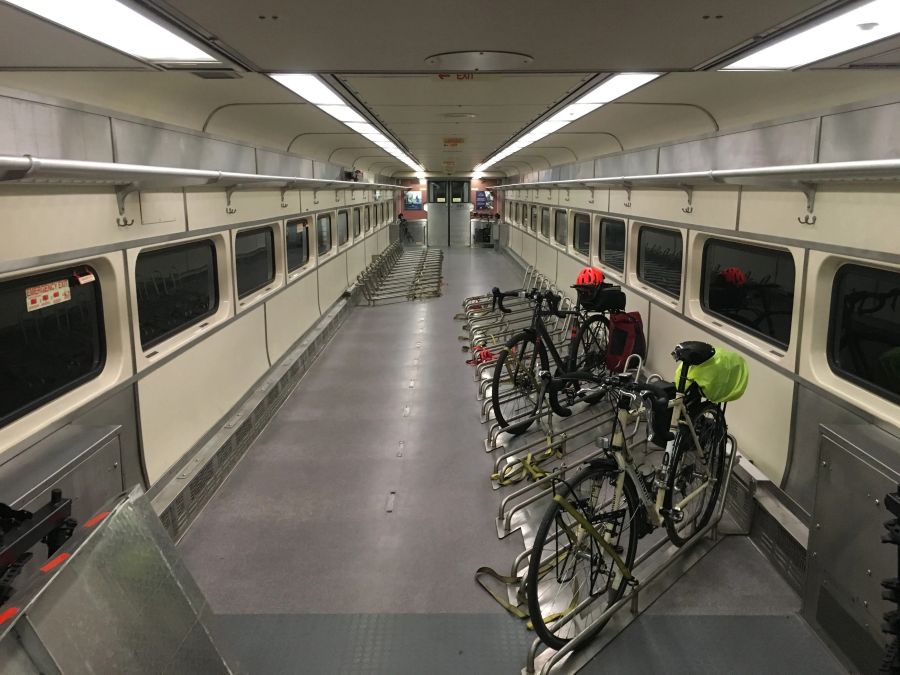
Bike travel in Germany is easy—if you know the quirks for each train type. Some trains are a breeze, others need more planning or advance bookings.
Regional Trains: RE, RB, and S-Bahn
If you’re sticking to local trips or hopping between towns, regional trains—like the RE (Regional Express), RB (RegionalBahn), and S-Bahn—are your best friends. Bikes are allowed on most of these, and honestly, I love them for day trips. You just roll your bike on, usually into the bike areas.
Most states make you buy a separate bike ticket, even with a regional pass. Some places let bikes ride free during off-peak times, but it’s a patchwork—always check before you board. During rush hour, especially on the S-Bahn, bikes might get banned or restricted—it’s all about giving space to commuters. If the train’s packed, conductors might ask you to wait.
Watch for signage and platform markings; the bike wagon is usually labeled with a big bike symbol. If you can, travel outside rush hour—unless you enjoy dodging dirty looks from folks squeezing past your handlebars.
Intercity and IC/EC Trains
For longer trips between cities, you’ll want Intercity (IC) or EuroCity (EC) trains. These do allow standard bikes on most routes, but you must reserve a spot for your bike in advance.
Reservations cost extra and fill up fast, especially in summer. The bike spaces are usually at the front or back of the train, clearly marked. Show your reservation to the conductor and you’re good. It’s simple—but don’t show up at the last minute expecting a spot.
Train staff might check your ticket and reservation, and sometimes even help with straps if the ride’s bumpy. Folding bikes usually don’t need reservations or extra tickets if they’re packed as luggage. If you’re crossing borders, some routes drop bike carriages—so check before booking.
ICE Trains: National High-Speed Services
ICE trains (Inter City Express) are the sleek, fast pride of German rail. But bikes and ICE have a complicated relationship. For years, regular bikes weren’t allowed at all—unless you could fold yours up small enough to count as luggage. I’ve made that mistake and had to scramble for a slow regional train instead.
Now, things are changing, but slowly. Some ICE trains offer limited bike spaces—sometimes just two to four, usually on newer lines. Like with IC trains, you have to book your bike space in advance and pay extra. Even then, get to the platform early to find your carriage—miss it and you’re out of luck.
If you’ve got a bike bag and can break your ride down, you might squeak by as “carry-on.” Otherwise, ICE is still mostly “bike-unfriendly.” Bring your patience, double-check your ticket, and maybe have a backup route in mind.
International Trains: EuroCity and TGV
Crossing borders with your bike on a train? It’s a bit of a puzzle, honestly. EuroCity trains make things easier between Germany and neighbors like Switzerland, Austria, or the Czech Republic. You’ll still need to book that bike slot ahead of time and snag a reservation ticket, so don’t just show up and hope for the best.
TGVs, especially when heading into France, really clamp down on bikes. Most of these speedy trains won’t take non-folding bikes unless you box them up. I’ve run into some no-nonsense TGV staff—definitely not the place to test your luck. Only a handful of TGVs crossing into Germany offer actual bike spaces, and those disappear quickly. If you want one, start planning months in advance.
- EuroCity: Reserve early; bikes stay assembled in specific areas.
- TGV: Only boxed bikes or special cases; check each train’s rules.
Traveling internationally with your bike means juggling all sorts of rules, languages, and unexpected platform changes. I always leave extra time and keep a backup plan handy. Expect delays or surprises, because, well, that’s just how these trips go.
How to Identify and Access Bike Spaces on Trains
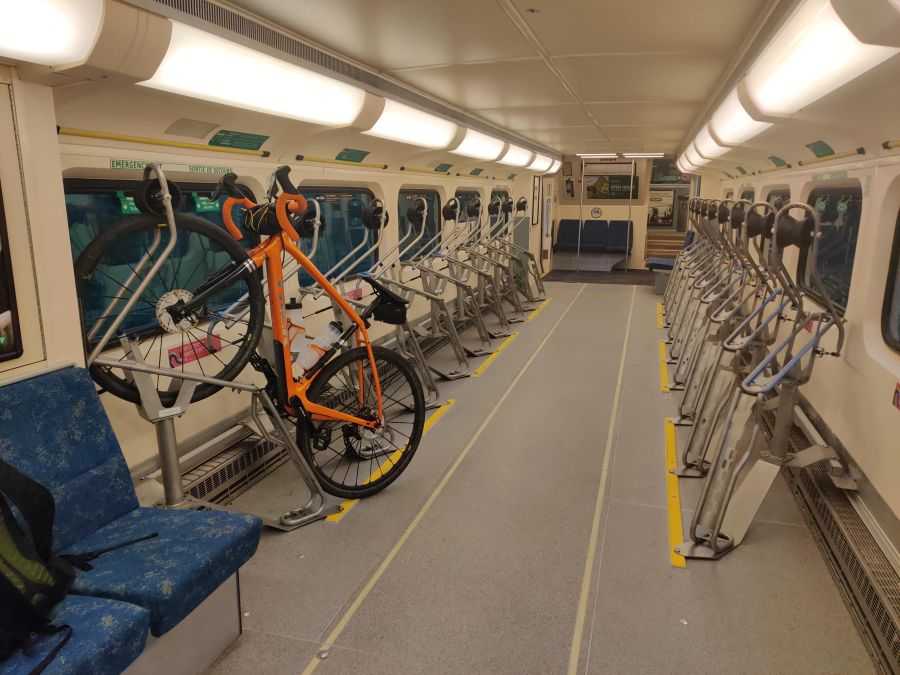
Taking your bike on a train in Germany can be a breeze—if you know what to look for. Spotting the right symbols and figuring out how to load your bike without chaos makes a world of difference. A bit of prep can save you a lot of stress.
Understanding the Bicycle Symbol
Watch for the bicycle symbol—that’s your golden ticket. Trains that allow bikes usually have a little bike logo on the outside of certain cars. Sometimes it’s right next to the doors, but I’ve also noticed it on platform screens and timetables.
Inside, you’ll see the bike sign above the actual parking spaces. These aren’t random spots; there’s usually a rack or hooks waiting for your wheels. On apps or online, that same symbol pops up next to bike-friendly trains.
Not every train has these spots, especially the fancy ICE trains. Always double-check before you roll up. I missed it once and had to back out with my bike—awkward doesn’t even begin to cover it.
Finding Bike Compartments and Coaches
Once you’ve found your train, the next step is figuring out where the bike compartments actually are. On regional trains, they’re usually at the ends or smack in the middle. Look for platform diagrams—they’ll show you where the bike car stops.
Long-distance trips usually mean you need a specific reservation, and your ticket should show the coach number. These coaches can be anywhere—front, back, or buried in the middle. I like to arrive early so I’m not scrambling down the platform last minute.
On the platform, search for ground markings or overhead signs. Some stations paint bike logos right where you’re supposed to wait. And honestly, if you’re lost, just ask a staff member—they’re usually happy to help.
Loading and Unloading Bicycles
Getting your bike on and off the train can be the trickiest part. German trains aren’t always level with the platform, especially the older regional ones, so you might need to lift your bike up a step. Don’t hesitate to accept help—fellow cyclists often lend a hand.
Once inside, roll straight to the marked bike space and use the straps provided. If there’s a rack, hook your front wheel first, then lift the back. It gets easier after a few tries. During busy times, you’ll need to shuffle your bike so others can pass. Always strap your bike before dealing with your bags—otherwise, you’ll end up with a pile of gear on the floor (been there).
When your stop is coming up, head to the door a couple of minutes early. German trains won’t wait for you. Unstrap your bike, grab your stuff, and get ready for a quick exit. It sounds stressful, but after a couple of trips, it becomes second nature.
Using Deutsche Bahn Services for Bike Travel
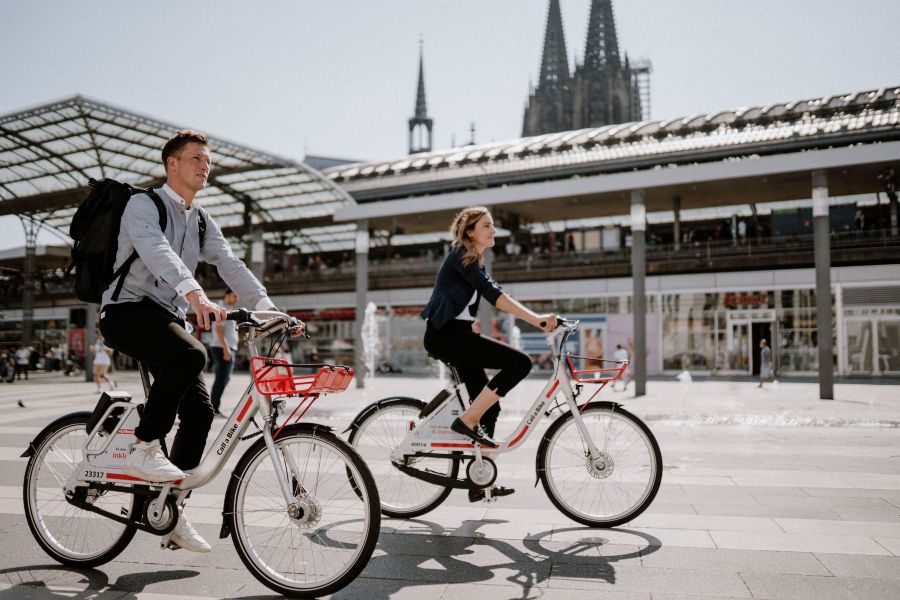
Most Deutsche Bahn trains take bikes, but figuring out the details and booking process can be confusing. Let’s break down the key steps so you don’t end up stranded with your bike and backpack.
If your German’s a bit rusty, don’t sweat it—Bahn.de and the DB Navigator app work well in English. You can search for connections that allow bikes and check for available space. Not every long-distance train (like IC or ICE) takes bikes, but regional trains usually do.
When you book, tick the bicycle box or use the filter so you only see bike-friendly trains. For long-distance routes, you’ll need both a bike ticket and a reservation for your bike space. If you skip the reservation, you risk being turned away, even if you have a regular bike ticket. Seriously, don’t miss this step!
The DB Navigator app lets you do it all on your phone—check train occupancy, reserve bike slots, and see at a glance if there’s space left. That’s a lifesaver during peak travel times.
Getting Help from DB Agencies
Not a fan of apps? DB’s travel agencies—DB Reisezentrum—can help in person. The staff there are used to sorting out last-minute issues, like rescheduling if you miss your train or if bike spots are full.
Walk up to the window, explain your situation, and they’ll check what’s available. They can print tickets, sort out reservations, and suggest easier stations for bike loading.
This is also the go-to for group bookings (6+ bikes), or if you already have your main ticket and need to add a bike. For tricky routes or last-minute changes, real human help can save your day—especially if your German isn’t perfect. Don’t try to wing it if you’re in a rush; let a DB agent steer you right.
Support for Connecting Journeys
Switching trains with a bike in big German stations like Frankfurt or Munich can be a headache. Timetables, platform crossings, and knowing which car to board with your bike—it’s a lot.
Both Bahn.de and the DB Navigator app offer journey planners that lay out each leg. Some connections are marked as fahrradfreundlich (bike-friendly), with longer transfer times or better platform access. Look for the little bike icon next to your connections.
Ask DB staff for help with elevators, ramps, or which end of the platform to wait at. Missing a connection with your bike isn’t fun, so build in extra time and pack light. Even after years on German trains, I still get tripped up by sudden platform changes. Station staff or fellow cyclists can often point you in the right direction.
Regional Differences and Transport Associations
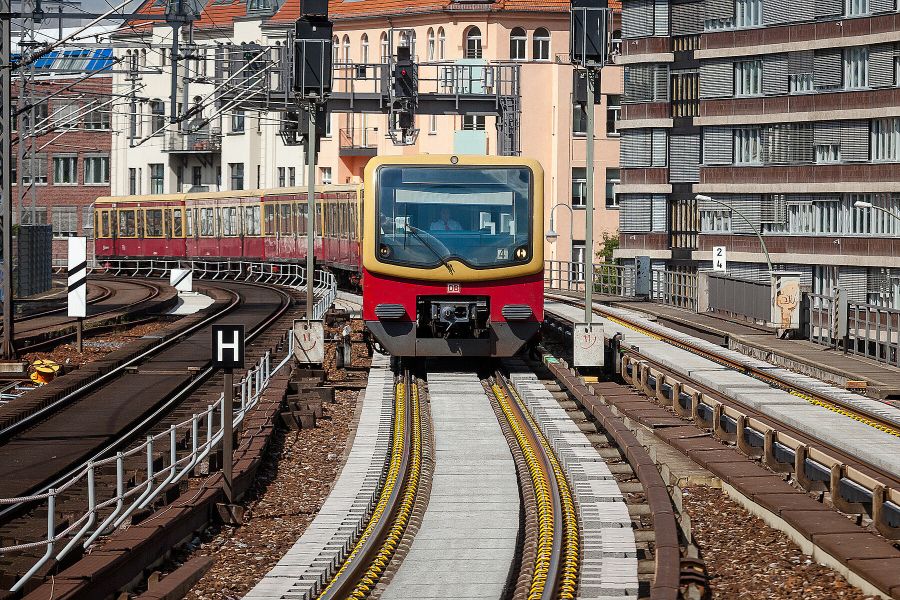
Taking your bike on German trains? The rules shift from region to region. Local transport associations, city policies, and cross-border quirks all play a part. Sometimes you won’t know the rules until you’re standing on the platform, bike in hand, hoping you guessed right.
Berlin and Brandenburg: S-Bahn and Beyond
Berlin’s S-Bahn makes life easy for cyclists—most lines allow bikes with a valid bike ticket. You can buy one from a machine or the app, no big deal.
But watch out for morning rush hour (about 6-9 am), when bikes aren’t allowed. The rule keeps the carriages from getting too packed. Outside those times, you’re good to go.
If you hit Friedrichstraße or Ostbahnhof at rush hour, you’ll see a crowd of bikes waiting to board. There’s an unspoken code—don’t squeeze your bike into an already full carriage, and always check for the bike symbol on the doors. No symbol, no entry.
Potsdam and Surrounding Regions
Heading out to Potsdam or the countryside? The Verkehrsverbund Berlin-Brandenburg (VBB) runs the show, and their rules mostly match Berlin’s, but expect a few curveballs.
You’ll need a VBB bike ticket, which usually covers local trains, buses, and trams. But some smaller regional lines have their own rules. Conductors can be strict—they might count bike spaces and turn you away if things are full.
On sunny weekends, everyone heads for the lakes with their bikes. Go early or later in the day for less chaos. Watch the station signage—boarding with your bike can get competitive, and sometimes you’ll get a polite “next train, please.”
Traveling near Borders: Poland Connections
Thinking about pedaling into Poland? The rules get murky fast, especially if your train switches from German to Polish operators. First, figure out which company runs your train—Deutsche Bahn, Koleje Dolnośląskie, or NEB all have their own set of requirements.
Bikes usually get on board, but space is tight, and there’s often a separate ticket or surcharge. I’ve had German conductors let me roll on, only to hit the border and meet a Polish conductor demanding another ticket. Be ready to buy a “Rower” (bike) ticket.
Pro tip: bring a bike bag if you’re unsure, since folded or bagged bikes usually count as luggage. Double-check with station staff, especially at border stops like Frankfurt Oder or Küstrin-Kietz, since signs aren’t always clear.
What to bring for Poland connections:
- Passport or ID card
- Separate bike ticket (sometimes both ways!)
- Patience—border delays are common
Coordinating with Regional Transport Associations
The patchwork of German “Verkehrsverbünde” (transport associations) can be a headache. Each region—Berlin, Brandenburg, Saxony, Bavaria—has its own bike rules. They publish them online or in leaflets, but rarely in plain English.
Watch out for blackout times—many regions ban bikes on local trains during weekday rush hours. Only board cars with bike pictograms, or the conductor might say no.
If you’re traveling with others, each bike usually needs its own ticket. Group discounts are rare, but some regions let folding bikes travel for free if folded properly.
If you’re unsure, ask staff or other cyclists at the platform. Keep an eye on electronic departure boards—the bike symbol means spaces are available. No symbol, no space, and you risk a fine. Staying alert and flexible is the best way to navigate Germany’s ever-changing bike transport scene.
Practical Tips for Cycling and Train Journeys
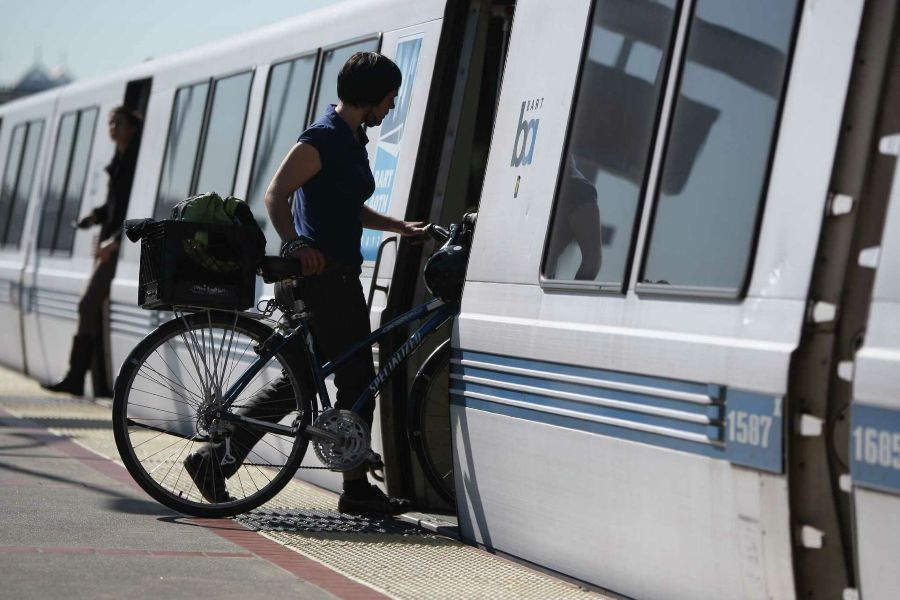
Every bike-and-train trip in Germany feels a bit different. If you want fewer headaches and a smoother ride, learn how to mix bike rental with train travel, avoid the busiest hours, and stash your bike like a pro.
Combining Bike Rental and Train Travel
You don’t have to lug your own bike everywhere—thank goodness. Rental bikes can spare you the hassle of dragging a heavy ride through the station, especially if you’re just cycling for a day or two.
In bigger cities and even some smaller towns, you’ll spot those easy-to-rent bikes. Deutsche Bahn (DB) runs their “Call a Bike” service, and plenty of private companies fill in the blanks where DB doesn’t reach.
I’ve landed somewhere, realized the train’s bike spaces were jammed, and just grabbed a rental on arrival. It’s way less stressful, and you’re not stranded if the conductor turns you away. Plus, you skip the bike ticket entirely (those ticket machines always seem to develop a queue when you’re already late).
Here’s a tip that’s saved me a few headaches: check if the rental allows one-way drop-off. There’s nothing worse than having to double back just to return a bike you never wanted to haul in the first place.
Timing Your Travel with Peak Hours
Trying to get on a train with your bike during German rush hour? I wouldn’t recommend it. Trains in big cities or touristy spots fill up fast from 7–9 AM and again from 4–7 PM.
I’ve stood there, sweaty and annoyed, while the conductor just shook his head—no more bikes allowed. If you can, travel mid-morning or early afternoon, right after the work crowd has cleared out.
Weekends and holidays aren’t always better, since day-trippers flood the trains. If your train allows it, always book your bike slot ahead of time. Regional trains don’t always let you reserve, but intercity and ICE trains do—just move fast, those spots disappear quickly.
Traveling off-peak means you avoid being packed in like sardines, and you actually get to enjoy the ride. No one wants to balance themselves and a bike in the vestibule while the train sways.
Storing Bikes and Avoiding Fines
German rail staff take bike rules seriously—no joke. If you stash your bike in the wrong spot, buy a ticket late, or block the doors, you could get fined or even kicked off at the next stop.
Look for the marked bike sections; you’ll spot the bike symbol outside the carriage. It’s not always obvious, so keep an eye out.
Here’s a quick table to keep things straight:
| Bike Type | Allowed as Luggage? | Special Rules |
|---|---|---|
| Folding Bike | Yes (when folded) | Counts as regular luggage |
| Kids’ Bike | Yes (under 40cm) | Store as luggage |
| Regular Bike | With Bike Ticket | Must fit in bike spaces |
If the bike racks are full, conductors can—and sometimes will—refuse you, even if you’ve got a ticket. Fat bikes with extra-wide tires rarely fit in the mounts; I’ve had to let out some air more than once (bring a mini-pump, trust me). Always keep your ticket handy and double-check the carriage number, since not every car takes bikes. Knowing these quirks ahead of time really saves your nerves and your wallet.
Frequently Asked Questions
Traveling across Germany by train with your bike can be smooth, but a few quirks can trip you up. Rules shift between train types, ticket needs, and what kind of bike you’re bringing.
What are the specific guidelines for bringing a bicycle on a Deutsche Bahn train?
You’ll need to keep your regular bike in the bicycle areas—look for the little bike symbol on the train. The staff can get grumpy if your bike blocks the aisles, so stick to the designated spots.
Not all carriages have racks, and the ones that do fill up fast during rush hour. If you want a spot, get there early.
Is a special ticket required to take a bike on trains within Germany?
Yep, you almost always need a separate bike ticket. For most regional trains, just grab a day pass for your bike from the machine or app. Don’t risk skipping it; fines aren’t cheap.
Some S-Bahn lines let you take your bike for free after the morning rush, but local rules change city to city. Long-distance and express trains? They’re stricter, and I’ve learned that the hard way.
How do travelers handle foldable bikes on German train services?
Foldable bikes are a total game changer, honestly. Once you fold it up, it counts as luggage—no ticket needed, just stash it with your suitcase or backpack.
I’ve tucked my Brompton under the seat more times than I can count, and nobody ever cared. Just don’t expect loads of space during peak hours.
What are the restrictions for taking bicycles on buses in Germany?
Full-size bikes and buses in Germany? Pretty much a no-go. Most city buses won’t let you bring one unless it folds up small.
A few long-distance coaches offer bike racks or trailers, but you’ll need to reserve a spot ahead of time. In some tourist areas, you might find special bike buses, but don’t count on it everywhere.
Are there any differences in rules for bicycle transport on regional vs. long-distance trains in Germany?
Definitely. Regional trains (like RE, RB, and S-Bahn) are much more relaxed about bikes and have spaces in most cars. You don’t have to reserve a spot, so getting on and off is simple.
Long-distance trains (IC or ICE) require you to reserve a spot for both yourself and your bike in advance. I missed out once thinking I could just show up—it doesn’t work like that. These trains have fewer spots and they fill up fast, especially around weekends and holidays.
Can electric bicycles also be taken on board German trains, and if so, are there any additional considerations?
You can actually bring most “Pedelecs”—that’s what they call standard e-bikes—on both regional and long-distance trains, as long as the motor doesn’t push you past 25 km/h.
But here’s the catch: super-heavy, oversized, or those zippy speed-pedelec bikes? Conductors usually won’t let them on board.
One thing people often overlook—charging on the train just isn’t possible. I’ve forgotten to charge my e-bike before a trip, and honestly, dragging a dead e-bike off a platform is a special kind of misery.
So, plug in before you head out. You’ll thank yourself later.



